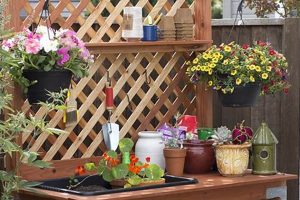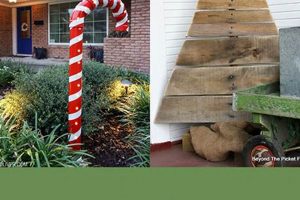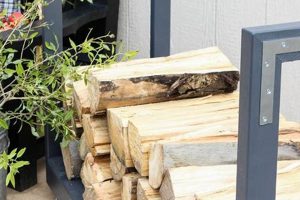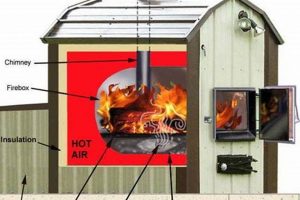Constructing a fire feature in an exterior space utilizing cost-effective methods and individual labor represents a project accessible to many homeowners. This approach prioritizes affordability and personalization, enabling the creation of an outdoor focal point without incurring significant expense. For example, a structure built from reclaimed bricks and a simple metal fire pit insert exemplifies this budget-conscious approach.
The appeal of economical, self-directed construction lies in its potential for customization and reduction of reliance on professional services. This facilitates significant savings and allows for a highly tailored aesthetic that reflects individual preferences. Historically, resourcefulness in building techniques has been a hallmark of owner-built projects, emphasizing practicality and creative problem-solving.
The subsequent sections will explore material selection, foundational considerations, design options, and safety protocols relevant to achieving a successful and durable fire feature that minimizes financial investment while maximizing enjoyment and aesthetic appeal.
Essential Guidance for Budget-Conscious Outdoor Fireplace Construction
The following recommendations are intended to guide individuals in the creation of an outdoor fire feature while adhering to principles of cost efficiency and personal labor. Successful project execution necessitates careful planning and diligent adherence to safety standards.
Tip 1: Prioritize Reclaimed and Repurposed Materials: Sourcing used bricks, concrete blocks, or natural stone can significantly reduce material costs. Scour local classifieds, salvage yards, and demolition sites for viable options. Ensure materials are structurally sound and appropriate for high-temperature applications.
Tip 2: Adopt a Simple Design: Intricate designs necessitate advanced construction skills and increased material quantities. Opt for a straightforward structure, such as a basic square or rectangular fire pit, to minimize complexity and labor requirements.
Tip 3: Establish a Solid Foundation: A stable base is crucial for the longevity of the fire feature. Excavate the site and create a compacted gravel or crushed stone foundation. This prevents settling and ensures the structure remains level over time.
Tip 4: Utilize a Cost-Effective Mortar Mix: Select a mortar mix specifically formulated for masonry applications. Pre-mixed options offer convenience, but mixing mortar from scratch can reduce material expenses. Adhere strictly to manufacturer instructions for optimal bonding strength.
Tip 5: Incorporate a Metal Fire Ring or Insert: A metal ring or insert provides a defined fire containment area and protects the surrounding masonry from direct heat exposure. These inserts are readily available at home improvement stores and offer a relatively inexpensive means of enhancing safety and durability.
Tip 6: Implement Proper Drainage: Integrate drainage solutions to prevent water accumulation within the fire pit. This helps to minimize the risk of freeze-thaw damage and prolong the lifespan of the structure. Consider incorporating a gravel base and drainage holes.
Tip 7: Maintain Adequate Clearance: Ensure sufficient clearance between the fire feature and any combustible materials, such as trees, fences, or structures. Consult local building codes and regulations for specific clearance requirements. This is paramount to safety and fire prevention.
Adhering to these guidelines will enable the construction of a functional and aesthetically pleasing outdoor fire feature within a reasonable budget, fostering an inviting ambiance while promoting responsible and safe use.
The subsequent stages of this exposition will delve into safety considerations, maintenance procedures, and supplementary design elements that further enhance the value and enjoyment derived from the constructed fire feature.
1. Material Acquisition
Material acquisition strategies are central to realizing a low-cost, owner-built outdoor fireplace. The selection and procurement of materials directly influence both the overall expense and the aesthetic outcome of the project. Thoughtful planning in this phase is critical for achieving cost-effectiveness without compromising safety or structural integrity.
- Reclaimed and Recycled Materials
The utilization of reclaimed or recycled materials, such as bricks, stones, or concrete blocks sourced from demolition sites or salvage yards, presents a significant opportunity for cost reduction. These materials often possess a unique aesthetic character and are available at a fraction of the price of new materials. Rigorous inspection for structural soundness and suitability for high-temperature applications is mandatory.
- Local Sourcing and Bulk Purchasing
Sourcing materials from local suppliers minimizes transportation costs and supports regional businesses. Purchasing materials in bulk quantities, when feasible, can often yield discounts. Thorough research of local material providers and price negotiation are essential components of this approach.
- Alternative Material Options
Exploring alternative materials beyond traditional masonry products can offer further cost savings. For instance, utilizing fire-rated concrete pavers for the exterior cladding or incorporating readily available landscaping stones can provide a visually appealing and structurally sound alternative at a lower price point. A feasibility analysis, confirming its application, should be performed.
- Material Calculation and Waste Minimization
Accurate material calculations and waste minimization strategies are crucial for avoiding unnecessary expenses. Precise measurements of the intended fireplace dimensions and careful planning of material layout can significantly reduce the amount of waste generated during construction. This translates directly into reduced material costs.
The integration of strategic material acquisition practices is instrumental in achieving the objective of a budget-friendly outdoor fireplace. By prioritizing reclaimed materials, leveraging local resources, exploring alternative options, and minimizing waste, project costs can be substantially reduced, making the construction of an outdoor fire feature accessible to a broader range of individuals.
2. Design Simplicity
Design simplicity is intrinsically linked to affordable, owner-built outdoor fireplaces. The complexity of a design directly correlates with material costs, labor requirements, and the potential for errors during construction. A simplified design minimizes the need for specialized tools, intricate cuts, and complex assembly techniques, thereby reducing overall project expenses. For example, a basic square or rectangular fire pit constructed from readily available concrete blocks demands less material and skill compared to a multi-tiered structure with elaborate stonework. The adoption of uncomplicated forms facilitates efficient material utilization and streamlines the construction process.
Further illustrating the connection, a design prioritizing straight lines and uniform shapes allows for easier cutting and fitting of materials. This reduces material waste and minimizes the time required for assembly. Moreover, a less complex structure often necessitates fewer specialized skills, making it accessible to individuals with limited construction experience. A simple, functional design does not necessarily equate to aesthetic compromise. Thoughtful material selection and careful attention to detail can yield a visually appealing fire feature even with a basic structural form. The focus shifts from elaborate ornamentation to the inherent beauty of the chosen materials and the clean lines of the design.
In summary, embracing design simplicity is a critical factor in achieving an economical outdoor fireplace project. It minimizes material costs, reduces labor requirements, and simplifies the construction process, making the project feasible for a broader range of individuals. While complex designs may offer greater visual impact, a well-executed simple design can provide both functionality and aesthetic appeal, aligning with the core principles of cost-effective, owner-built construction. Challenges may arise in balancing aesthetic preferences with budgetary constraints, but prioritizing functionality and simplicity ultimately contributes to a successful and affordable outcome.
3. Foundation Stability
Foundation stability serves as a non-negotiable prerequisite for any durable outdoor fireplace, regardless of budgetary constraints. The integrity of the base directly impacts the overall structural integrity and longevity of the fire feature. Without a stable foundation, shifting, cracking, and eventual collapse are foreseeable consequences, rendering the initial cost savings of a “cheap” DIY approach inconsequential. For instance, an outdoor fireplace constructed on unprepared soil is likely to suffer from settling, particularly in regions with freeze-thaw cycles. This settling can lead to cracks in the masonry, compromising its structural integrity and potentially creating a safety hazard.
Achieving adequate foundation stability without incurring substantial expenses involves several practical considerations. Proper site preparation, including excavation and compaction, is paramount. A layer of compacted gravel or crushed stone provides a stable and well-drained base. The use of concrete pavers or a poured concrete pad offers a more robust solution but increases material costs. However, investing in a solid foundation, even with slightly higher initial expenses, represents a cost-effective strategy in the long run by preventing costly repairs and ensuring the fireplace’s continued functionality and safety. Furthermore, consider the soil composition; expansive clay soils, for example, require more extensive ground preparation than sandy or gravelly soils.
In summary, foundation stability is not a component that should be compromised in the pursuit of a “cheap” outdoor fireplace. A well-prepared and stable foundation mitigates the risk of structural failure, ensuring the long-term viability and safety of the fire feature. While various cost-effective methods exist for achieving adequate stability, skimping on this crucial element ultimately proves detrimental to the overall success of the project. The understanding of soil composition and local climate factors is critical for effective foundation design, optimizing durability while minimizing expense.
4. Safety Protocols
The imperative of adhering to stringent safety protocols during the construction of an affordable, owner-built outdoor fireplace cannot be overstated. Compromising safety to reduce costs introduces significant risks, potentially leading to severe injury, property damage, and legal liabilities. A thorough understanding and implementation of safety measures are essential for a successful and responsible project.
- Clearance from Combustible Materials
Maintaining adequate clearance between the fireplace structure and any combustible materials, such as trees, fences, or building structures, is paramount. Failure to do so significantly increases the risk of accidental fires. Local building codes specify minimum clearance distances, which must be strictly observed. For example, proximity to overhanging tree branches poses a significant fire hazard and should be avoided.
- Proper Ventilation and Smoke Management
Ensuring proper ventilation and smoke management is crucial for preventing the build-up of hazardous fumes and ensuring a comfortable user experience. A well-designed chimney or flue facilitates the efficient removal of smoke. The prevailing wind direction should be considered when positioning the fireplace to minimize smoke exposure to surrounding properties. Regular cleaning of the chimney is also necessary to prevent creosote build-up, a highly flammable substance.
- Fire-Resistant Materials and Construction Techniques
The selection of fire-resistant materials and the application of appropriate construction techniques are essential for preventing structural failure and minimizing the risk of fire spread. Fire-rated bricks, blocks, and mortar should be used in the construction of the firebox. Proper reinforcement techniques, such as the use of steel rebar, enhance the structural integrity of the fireplace and prevent cracking or collapse under high temperatures. Avoiding the use of materials with flammable components such as non-fire-rated concrete is vital.
- Fire Extinguisher Accessibility and Emergency Planning
Maintaining easy access to a fire extinguisher and developing a comprehensive emergency plan are crucial in the event of an accidental fire. All users of the fireplace should be familiar with the operation of the fire extinguisher and the procedures to follow in case of a fire. A readily accessible water source, such as a garden hose, should also be available. Regularly inspecting the extinguisher and establishing clear communication protocols help mitigate danger.
Neglecting these safety protocols in the pursuit of an inexpensive outdoor fireplace project introduces unacceptable levels of risk. Prioritizing safety, even if it entails a slight increase in initial costs, is a responsible and prudent approach that ensures the long-term enjoyment and safety of the fire feature and its surroundings. Compliance with local regulations, coupled with a thorough understanding of fire safety principles, forms the foundation of a successful and safe outdoor fireplace construction endeavor. Therefore, prioritizing safety enhances the value of the completed fireplace.
5. Code Compliance
Adherence to local building codes represents a critical, often overlooked, component of any do-it-yourself outdoor fireplace project, particularly when the intention is to minimize costs. The assumption that a “cheap” build excuses one from regulatory obligations is demonstrably false and can lead to significant repercussions. Code compliance dictates specifications for setbacks, material types, chimney heights, and fire safety features, all of which directly influence the design and construction process. Ignoring these regulations, even in pursuit of cost savings, can result in mandatory modifications, fines, or even the complete dismantling of the structure by local authorities. For example, a homeowner who constructs a fireplace too close to a property line, neglecting setback requirements specified in local ordinances, may be ordered to relocate the entire structure at considerable expense, effectively negating any initial savings.
The relationship between code compliance and cost-effectiveness is not inherently adversarial. In many cases, understanding and adhering to codes from the outset can actually reduce long-term costs. Codes often mandate safety features, such as spark arrestors or fire-resistant materials, that, while adding to the initial expense, minimize the risk of fire damage and related liabilities. Furthermore, compliance with building codes ensures that the structure meets minimum standards of durability and safety, preventing premature failure and costly repairs. Seeking guidance from local building officials before commencing the project allows for informed decision-making and ensures that the design aligns with regulatory requirements, avoiding potential pitfalls down the line.
In conclusion, the pursuit of an economical outdoor fireplace project necessitates a proactive and informed approach to code compliance. Viewing building codes not as an impediment but as a guide to safe and durable construction can transform the relationship between initial cost savings and long-term value. Neglecting these regulations introduces significant risks and potential expenses that ultimately undermine the goal of a “cheap” DIY project. Therefore, understanding and adhering to local building codes is not merely a legal obligation but a fundamental element of responsible and cost-effective construction.
6. Maintenance Planning
Diligent maintenance planning is integral to the long-term viability of an outdoor fireplace constructed with cost-effective methods and owner labor. While the initial appeal of such projects lies in reduced upfront expenses, neglecting subsequent maintenance can negate these savings through premature deterioration and costly repairs. Maintenance planning encompasses proactive measures to safeguard the structure against the elements, prevent material degradation, and ensure continued safe operation. For example, a fireplace built using reclaimed bricks, while economical, may be more susceptible to moisture damage compared to one constructed with new, high-quality materials. A maintenance plan addressing this vulnerability would include annual sealing of the brickwork to prevent water ingress and subsequent freeze-thaw damage, thus extending the structure’s lifespan and averting expensive reconstruction.
Effective maintenance planning extends beyond simple repairs and encompasses regular inspections, cleaning protocols, and preventative measures. Chimney sweeping, for instance, removes creosote buildup, mitigating the risk of chimney fires and ensuring efficient smoke venting. Inspecting mortar joints for cracks and performing necessary repointing prevents water penetration and structural instability. Covering the fireplace during periods of heavy precipitation or snowfall minimizes exposure to the elements and reduces the likelihood of material degradation. Failing to implement these practices can lead to accelerated deterioration, requiring more extensive and costly repairs in the long run. For instance, neglecting chimney cleaning can result in a chimney fire, potentially causing significant damage to the fireplace structure and surrounding property.
In summary, the financial prudence of constructing a budget-conscious outdoor fireplace hinges on a comprehensive maintenance plan. Proactive measures, such as regular inspections, cleaning, and preventative repairs, safeguard the initial investment and ensure the continued safe and functional operation of the fire feature. While the temptation to minimize ongoing expenses may exist, neglecting maintenance ultimately undermines the long-term cost-effectiveness of the project. The challenges inherent in balancing limited resources with the need for consistent upkeep can be addressed through careful prioritization and a commitment to preventative maintenance practices. Therefore, a well-defined maintenance plan transforms a potentially short-lived, inexpensive project into a durable and cost-effective outdoor amenity.
Frequently Asked Questions
The following questions address common concerns and misconceptions surrounding the construction of outdoor fireplaces with a focus on cost minimization. The responses aim to provide clear, informative guidance based on established construction principles and safety considerations.
Question 1: Is it genuinely feasible to construct an outdoor fireplace using inexpensive DIY methods without compromising safety or structural integrity?
Achieving a balance between cost-effectiveness and safety requires careful planning, material selection, and adherence to sound construction practices. The feasibility depends largely on the scale and complexity of the design, as well as the homeowner’s skill level. Smaller, simpler designs utilizing reclaimed or readily available materials can be successfully executed within a limited budget, provided all safety protocols and building code requirements are strictly observed. Compromising on essential safety features or structural elements in the interest of saving money is ill-advised and potentially dangerous.
Question 2: What are the most common mistakes to avoid when building a budget-friendly outdoor fireplace?
Common mistakes include neglecting foundation stability, failing to obtain necessary permits, using inappropriate or combustible materials near the firebox, ignoring proper ventilation, and disregarding safe clearance distances from surrounding structures and vegetation. Insufficient research and planning also contribute to errors. Shortcuts in construction, motivated by cost savings, frequently lead to structural deficiencies and increased maintenance costs in the long term.
Question 3: How critical is it to obtain building permits for a DIY outdoor fireplace project, even when aiming for a “cheap” build?
Obtaining the necessary building permits is not merely a formality but a critical step in ensuring the safety and legality of the construction. Permits ensure that the design adheres to local building codes and safety regulations, minimizing the risk of fire hazards and structural failures. Failure to obtain permits can result in fines, mandatory modifications, or even the complete removal of the structure. Contacting the local building department is crucial for understanding the specific requirements and obtaining the necessary approvals.
Question 4: What alternative materials can be used to lower costs without sacrificing durability and appearance?
Several alternative materials can be considered to reduce expenses. Reclaimed bricks or stones offer a cost-effective and aesthetically pleasing option. Fire-rated concrete blocks provide a durable and readily available alternative to traditional masonry. Utilizing gravel or crushed stone for the foundation is less expensive than poured concrete. However, careful consideration must be given to the suitability of each material for high-temperature applications and exposure to the elements.
Question 5: How can the design be simplified to minimize construction complexity and material costs?
Opting for a simple, geometric design, such as a square or rectangular fire pit, minimizes the need for intricate cuts and specialized construction techniques. Straight lines and uniform shapes simplify material layout and assembly. Reducing the overall size of the fireplace also lowers material costs and labor requirements. Focusing on functionality and essential features, rather than elaborate ornamentation, can further streamline the design and reduce expenses.
Question 6: What maintenance tasks are essential to prolong the life of an economical outdoor fireplace?
Essential maintenance tasks include regular chimney sweeping to prevent creosote buildup, inspecting and repointing mortar joints, cleaning the firebox to remove ash and debris, and covering the fireplace during periods of inclement weather. Applying a sealant to the masonry can protect against moisture damage. Addressing minor repairs promptly prevents them from escalating into more significant and costly problems.
In conclusion, while achieving an affordable outdoor fireplace requires careful planning and resourcefulness, safety and code compliance must remain paramount. A well-executed plan balances cost-effectiveness with durability, functionality, and adherence to all applicable regulations.
The subsequent section will explore potential design variations and aesthetic enhancements that can be incorporated without substantially increasing project costs.
Concluding Remarks on Economical Outdoor Fireplace Construction
The preceding examination of budget-conscious, owner-built outdoor fireplaces emphasizes the critical interplay between cost-effectiveness, safety, and regulatory compliance. A simplistic approach emphasizing reclaimed materials, basic designs, and rigorous adherence to code serves as a foundational principle. Strategic planning in material acquisition, meticulous foundation preparation, and unwavering commitment to safety protocols remain indispensable elements in the successful realization of such projects.
While the allure of minimizing expenses is undeniable, neglecting essential safety measures, code adherence, or structural integrity constitutes an untenable risk. Prioritizing informed decision-making, diligent execution, and proactive maintenance ensures the longevity, functionality, and safety of the resulting structure. Individuals embarking on these endeavors are encouraged to adopt a comprehensive approach, recognizing the enduring value of responsible construction practices over fleeting cost savings. Therefore, embarking on any project involving open flames requires thorough diligence and respect for both the inherent risks and applicable regulations.







